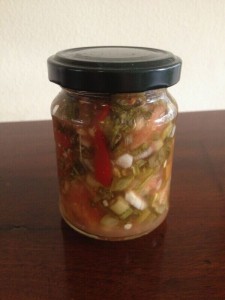 Lactic acid created by the lactobacilli help with digestion by breaking down the foods. This process makes a relish such as this an ideal condiment to add to any meal.
Lactic acid created by the lactobacilli help with digestion by breaking down the foods. This process makes a relish such as this an ideal condiment to add to any meal.
Ingredients
4 ripe tomatoes, peeled, seeded and chopped
1 bunch of spring onions, chopped
1 green pepper, seeded and chopped
2 red chillies, seeded and chopped
1 bunch of coriander, chopped
3 cloves garlic, crushed
4 tablespoons of whey
10g sea salt
1/2 cup of filtered water
Method
Peel tomatoes by first blanching in boiling water.
Mix all ingredients in a bowl and pound them lightly with a pestle, flat end of rolling pin or wooden meat hammer.
Place in a wide mouthed jar and press down lightly with your utensil until the liquid completely covers the tomato mixture.
The top of the vegetables should be at least 2cm below the top of the jar.
Seal the jar and keep at room temperature for 1 week before transferring to cold storage. Undo the lid slightly each day that the jar is at room temperature to release any CO2.
*
Click here for more information on making successful ferments.
This recipe comes from Nourishing Traditions by Sally Fallon, co-founder of the Weston Price Foundation.

So I made this today and it smelt so good! But I was wondering about a couple of things. Do you think it will still turn out ok without the whey in order to make it vegan? And why do you think Sally Fallon says to de-seed the tomatoes – do they inhibit the fermentation process do you think? It seems such a waste since a lot of a tomato is its seeds!
Thanks.
Hi Jane
I’m really pleased that you are enjoying fermenting. Yes – I have made this recipe with an extra 10g of sea salt instead of the whey and it turned out really well.
The original recipe says to use 1 tablespoon of sea salt (instead of 10g), but how much salt you actually get using this method depends on the grain of the salt. My batch came out lovely with an extra tablespoon of sea salt (coarse) whereas my friend’s, with a tablespoon of finely ground sea salt, came out a bit too salty. When we weighed them we found that a tablespoon of coarse sea salt came to 10g and a tablespoon of finely ground sea salt came to 20g.
I also left the tomato seeds in. I imagine that omitting them is just for cosmetic purposes.
I hope this helps
Katie
Pingback: how to make sauerkraut?